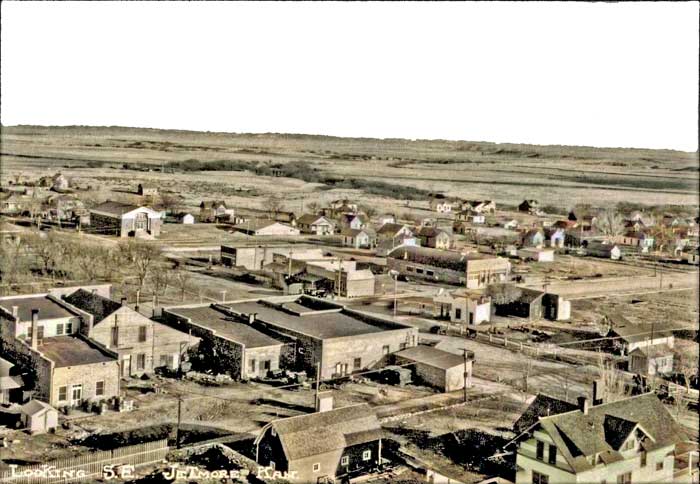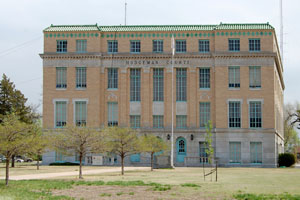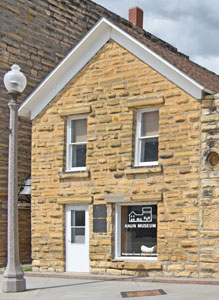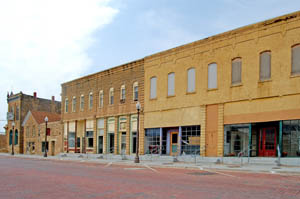Jetmore, Kansas, the county seat of Hodgeman County, was initially called Buckner when it was laid out in 1879. As of the 2020 census, the population of the city was 770.
Located near the county’s geographical center, it is situated along Buckner Creek, a tributary of the Pawnee River.
After the organization of Hodgeman County in March 1879, Hodgeman Center was made the first temporary county seat.
The first building erected in Jetmore was the Haun House on the West side of Main Street. It was built in 1879 by Thompson S. and Elizabeth Best Haun, who arrived in Hodgeman County from Clinton, Iowa, in 1878, when the county was just being organized. The two-story building held their home on the lower level, and the first newspaper in the county was established in an upstairs office. This building still stands and is now part of the Haun Museum.
On November 4, 1879, the people voted at the general election for the location of a permanent county seat, with the following result: Buckner, 199; Marena, 107; Hodgeman Center, 40; Fordham, 5.
Three days after the election, T. S. Haun circulated the first Issue of the Buckner Independent newspaper. In late 1879, a group from Buckner went to Hodgeman Center, gathered the county records, and brought them to the Haun House in Buckner.
The second building in Jetmore was a small frame building that was moved in on skids from Hodgeman Center. This building was used to house the county offices. The third building was a stone building on the East side of Main Street. The town well was dug at the intersection of Main and Highway Streets.
The name of Buckner was changed to Jetmore in early 1880 in honor of Colonel Abraham Buckles Jetmore, a lawyer from Topeka, who was instrumental in securing a railroad line through the city and arranging for it to become the county seat.
On May 20, 1880, the Hodgeman Center Post Office, two and a half miles away, was moved to Jetmore, and W.A. Frush served as the first postmaster.
From early 1881 to the spring of 1882, the county commissioners leased the east upstairs room of the Haun house for county offices and a courtroom. The house was also used as a community center, Sunday School classes, and social events.
On March 25, 1882, T.S. and Elizabeth Haun platted and laid out the original townsite. That year, the Haun family moved one mile outside Jetmore and rented their house in town to C. E. Roughton, who used it as a residence and established the first store in Jetmore.
The Hauns were instrumental in the town’s early growth, donating sites for the courthouse, a school, two churches, and an academy and a musical institute. Thompson S. Haun was a successful rancher and lawyer who served a term as county attorney.
The first school term was taught by Mina Gordon in 1883 with three students. The second term was in a building on Main Street and another on the creek bank near the old light plant. In the fall and winter of 1885-86, a stone School Building was erected and used for many years. It also housed church services, literary societies, debates, and many other functions.
The City of Jetmore was incorporated as a third-class city on May 3, 1887, with C.E. Roughton elected the first mayor.
Thompson S. Haun was elected to the state legislature in 1887. His last law office was at Kinsley in Edwards County, where he died in February 1920.
In the late 1880s, Jetmore was prosperous, and many limestone buildings, including the first stone courthouse, were erected. A real estate advertisement in 1889 boasted the town had three hotels, two banks, three restaurants, four general stores, three drug stores, three lumber yards, three blacksmith shops, a carriage shop, an implement store, three millinery shops, two hardware stores, three grocery stores, a clothing store, two feed stores, three weekly newspapers, five real estate agencies, several livery barns, barber shops, and furniture stores.
The first telephone system was started on February 19, 1904.
In 1910, Jetmore was the western terminus of a division of the Atchison, Topeka & Santa Fe Railroad, which connected with the main line at Larned, Kansas. At that time, Jetmore had a bank, two weekly newspapers — the Western Herald and the Republican; several business concerns; Congregational, Methodist, and Presbyterian churches; telephone, telegraph, and express facilities; a graded public school; an international money order post office, and a population of 317.

Jetmore, Kansas, 1927. Photo courtesy of the Haun Museum. Touch of color by LOA.
In 1929, a new three-and-one-half-story Hodgeman County Courthouse was built at 500 Main Street in Jetmore, Kansas. Reflecting the Second Renaissance Revival style, it is situated in the center of the public square. It was designed by Routledge and Hertz Architects and Builders of Hutchinson, Kansas, and replaced an 1886 limestone structure.
Jetmore’s population peaked in 1960 at 1,028.
The T. S. Haun House was given to Hodgeman County in 1964 by Margaret Raser, a daughter of the Hauns, for use as a museum. The house is significant not only because it served so many functions for Jetmore and Hodgeman County, but also because of the contributions of Thompson S. Haun to the settlement and growth of the area.

Another Hodgeman County Courthouse was built in 1929. It continues to serve the county today. Photo by Kathy Alexander.
Also See:
Sources:
Blackmar, Frank W.; Kansas: A Cyclopedia of State History, Vol I; Standard Publishing Company, Chicago, IL 1912.
Cutler, William G; History of Kansas; A. T. Andreas, Chicago, IL, 1883.
Jetmore, Kansas
National Historic Register – Hahn House
Wikipedia
Huan Museum




